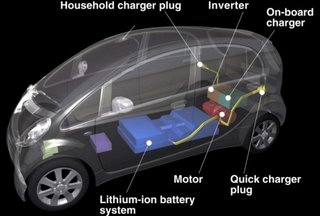Last week Mitsubishi announced the production of a small-electric vehicle based on the Mitsubishi i currently sold in Japan. Unfortunately, it will initially serve only as experimental vehicle for testing with component suppliers and technology validation. And when on sale, it will probably be offered only to lease companies.
But the interesting bits of this announcement go beyound last week’s news. Just like the Zytek-developed electric Smart ForTwo (check previous news on that), the Mitsubishi i has the most interesting architecture for a EV conversion: rear-engine, rear-wheel drive (actually sort of mid-engine and with a 4WD option – and yes, I know this sounds very cool but chill because these are very small underpowered city vehicles not sportscars); elevated driving position with space under-floor. This is all very good to place the electric engine in the back and the batteries under the floor. On top of that, both the Smart and the Mitsubishi are city-oriented vehicles and very light, the ideal field for the beginning of electrification.
It will be interesting to check the handling of these vehicles: the current Smart simply doesn’t handle but the weight of the batteries of the EV version will lower the centre of gravity and hopefully improve things a bit. The Mitsubishi has the advantage of a bigger wheelbase but… yes, chill again with the handling and back to the EV green future. Just look at the i and check how futuristic it looks… just the right shape for a ground-breaking mass-selling EV. In the meantime, while Mitsubishi decides if a future generation of the i-model will be sold in Europe, auto-future announces that will gladly give advice on five or six modifications that need to be done in order to make it more appealing to European tastes. Simple things that can make the difference, and we can give that advice for free, just ask and we will hapilly help. And these are not big changes, probably things that product managers could think about before being distracted with results from consumer clinics.
Other interesting bits. Who are the driving forces of EV research, development and market introduction? People from Tesla, their founders and supporters from Silicon-Valley. Almost completely outside the auto industry. The Smart EV was developed by a British company, Zytek, without input from Daimler-Chrysler until just recently. Mitsubishi is gambling its future on EV because it is now a company abandoned by Daimler-Chrysler, left to its own in a rather cloudy future: a big incentive for thinking (and doing) out of the box. Subaru, another independent company with strong roots in the small-car market in Japan. Their EV R1 model is highly awaited because… yes, because Subaru is no longer independent being associated with Toyota. It will be interesting to watch the outcome of that… So, the big auto companies are not investing a lot in small EV vehicles (or EVs at all). This doesn’t happen by chance…
.


But the interesting bits of this announcement go beyound last week’s news. Just like the Zytek-developed electric Smart ForTwo (check previous news on that), the Mitsubishi i has the most interesting architecture for a EV conversion: rear-engine, rear-wheel drive (actually sort of mid-engine and with a 4WD option – and yes, I know this sounds very cool but chill because these are very small underpowered city vehicles not sportscars); elevated driving position with space under-floor. This is all very good to place the electric engine in the back and the batteries under the floor. On top of that, both the Smart and the Mitsubishi are city-oriented vehicles and very light, the ideal field for the beginning of electrification.
It will be interesting to check the handling of these vehicles: the current Smart simply doesn’t handle but the weight of the batteries of the EV version will lower the centre of gravity and hopefully improve things a bit. The Mitsubishi has the advantage of a bigger wheelbase but… yes, chill again with the handling and back to the EV green future. Just look at the i and check how futuristic it looks… just the right shape for a ground-breaking mass-selling EV. In the meantime, while Mitsubishi decides if a future generation of the i-model will be sold in Europe, auto-future announces that will gladly give advice on five or six modifications that need to be done in order to make it more appealing to European tastes. Simple things that can make the difference, and we can give that advice for free, just ask and we will hapilly help. And these are not big changes, probably things that product managers could think about before being distracted with results from consumer clinics.
Other interesting bits. Who are the driving forces of EV research, development and market introduction? People from Tesla, their founders and supporters from Silicon-Valley. Almost completely outside the auto industry. The Smart EV was developed by a British company, Zytek, without input from Daimler-Chrysler until just recently. Mitsubishi is gambling its future on EV because it is now a company abandoned by Daimler-Chrysler, left to its own in a rather cloudy future: a big incentive for thinking (and doing) out of the box. Subaru, another independent company with strong roots in the small-car market in Japan. Their EV R1 model is highly awaited because… yes, because Subaru is no longer independent being associated with Toyota. It will be interesting to watch the outcome of that… So, the big auto companies are not investing a lot in small EV vehicles (or EVs at all). This doesn’t happen by chance…
.





No comments:
Post a Comment